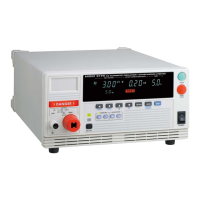121
99
This instrument can be controlled via the RS-232C and GP-IB.
Before Use
• The symbol shown below indicates that the following instructions are specific
to the RS-232C or the GP-IB interface. Instructions without this symbol are for
both the RS-232C and the GP-IB interface.
: GP-IB only
: RS-232C only
The GP-IB can only be used with the 3174-01 AC Automatic Insulation/With-
standing HiTester.
• Always make use of the connector screws to affix the GP-IB or RS-232C con-
nectors.
• When issuing commands that contain data, make certain that the data is pro-
vided in the specified format.
• The IEEE 488.2-1987 common command (required) can be used.
• Complies with the following standard: Applicable standard IEEE 488.1-1987
*1
• This instrument is designed with reference to the following standard: Refer-
ence standard IEEE 488.2-1987
*2
• If the output queue becomes full, a query error is generated and the output
queue is cleared. Therefore, clearing the output queue and query error output
from the deadlocked condition
*3
as defined in IEEE 488.2 is not supported.
RS-232C/GP-IB
Interface Chapter 9
To increase test efficiency, this instrument can be controlled by external I/
O or RS-232C and GP-IB and can start tests automatically. As a result,
there is a danger of electric shock accidents. Measures to prevent people
from coming near the instrument or the tested object unintentionally must
be taken when starting the instrument automatically. Wear insulated gloves
and confirm that automatic control is off before changing the tested object
or touching the test lead and tested object directly.
3174 (-01)
PC
Response Messages
Program Messages
*1. ANSI/IEEE Standard 488.1-1987, IEEE Standard Digital Interface for Programmable
Instrumentation
*2. ANSI/IEEE Standard 488.2-1987, IEEE Standard Codes, Formats, Protocols, and
Common Commands
*3. The situation in which the input buffer and the output queue become full, so that
processing cannot continue.

